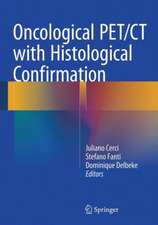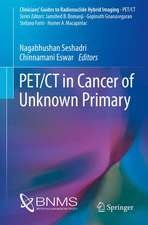Radioguided Surgery: Current Applications and Innovative Directions in Clinical Practice
Editat de Ken Herrmann, Omgo Nieweg, Stephen P. Povoskien Limba Engleză Hardback – 18 mar 2016
| Toate formatele și edițiile | Preț | Express |
|---|---|---|
| Paperback (1) | 744.39 lei 38-44 zile | |
| Springer International Publishing – 24 apr 2018 | 744.39 lei 38-44 zile | |
| Hardback (1) | 1127.03 lei 3-5 săpt. | |
| Springer International Publishing – 18 mar 2016 | 1127.03 lei 3-5 săpt. |
Preț: 1127.03 lei
Preț vechi: 1186.34 lei
-5% Nou
Puncte Express: 1691
Preț estimativ în valută:
215.79€ • 221.35$ • 181.68£
215.79€ • 221.35$ • 181.68£
Carte disponibilă
Livrare economică 05-19 februarie
Preluare comenzi: 021 569.72.76
Specificații
ISBN-13: 9783319260495
ISBN-10: 3319260499
Pagini: 501
Ilustrații: XVIII, 503 p. 142 illus., 125 illus. in color.
Dimensiuni: 178 x 254 x 34 mm
Greutate: 1.44 kg
Ediția:1st ed. 2016
Editura: Springer International Publishing
Colecția Springer
Locul publicării:Cham, Switzerland
ISBN-10: 3319260499
Pagini: 501
Ilustrații: XVIII, 503 p. 142 illus., 125 illus. in color.
Dimensiuni: 178 x 254 x 34 mm
Greutate: 1.44 kg
Ediția:1st ed. 2016
Editura: Springer International Publishing
Colecția Springer
Locul publicării:Cham, Switzerland
Public țintă
Professional/practitionerCuprins
Part 1 Introduction.- The History of Radioguided Surgery: Early Historical Milestones and the Development of Later Innovative Clinical Applications.- Part 2 Detailed Methodology Part.- Physics of Radioguided Surgery.- The use of intraoperative small and large field of view gamma cameras for radioguided surgery.- Surgical Navigation.- Tracers applied in radioguided surgery.- Radiation Safety and Dosimetry.- Part 3 Clinical Application: Breast.- Radioguided sentinel lymph node mapping and biopsy in breast cancer.- Radioguided Surgery for Non-Palpable Breast Lesions: I-125 Radioactive Seed Localization.- Radioguided Surgery for Non-Palpable Breast Lesions: Technetium-99m Radioguided Occult Lesion Localization (ROLL).- Part 4 Clinical Application: Skin.- Radioguided sentinel lymph node mapping and biopsy in cutaneous melanoma.- Part 5 Clinical Application: Head and Neck.- Sentinel lymph node mapping and biopsy in oral cancer.- Part 6 Clinical Application: Thyroid and Parathyroid.- Radioguided sentinel lymph node mapping and biopsy in thyroid cancer.- Radioguided Parathyroid Surgery.- Radioguided surgery of thyroid carcinoma recurrences.- Part 7 Clinical Application: Urogenital Tract.- Radioguided sentinel lymph node biopsy and lymphatic mapping in urogenital malignancies.- Radioguided sentinel lymph node mapping and biopsy in Gynaecological malignancies .- Part 8 Clinical Application: Gastrointestinal Tract.- Radioguided sentinel lymph node mapping and biopsy in oesophago-gastric.- Radioguided sentinel lymph node mapping and biopsy in colorectal cancer.- Radioguided surgery in gastro-entero-pancreatic neuroendocrine tumors.- Part 9 Clinical Application: Thoracic.- Radioguided sentinel lymph node mapping and biopsy in non-small-cell lung cancer (NSCLC).- Radioguided surgery of small pulmonary nodules.- Part 10 Miscellaneous.- Radioguided localization of bone lesions.- Radioguided monitoring of systemic leakage during isolated limb perfusion.- Radioimmunoguided Surgery:Intraoperative radioimmunodetection for the radioguided localization and resection of tumors.- 18F-FDG-Directed Surgery and 18F-FDG-Directed Interventional Procedures.- Part 11 Outlook: New techniques, image fusion, optical imaging.- Fluorescent tracers, hybrid tracers.- Magnetic Advances in Cancer Surgery.- Ultrasound fusion.- Part 12 Examples (conventional techniques and innovations).
Recenzii
“This book is a milestone in this field as it was written by world leading nuclear medicine imaging specialists and surgeons and thus benefits from the multidisciplinary contributions of experts sharing their personal experience to enhance the quality of the work. Therefore, the book is of the utmost interest to a wide audience, including all physicians involved in the diagnosis and treatment of cancer patients, as well as general surgeons, nuclear medicine physicians, oncologists and pathologists.” (Giuseppe D. Di Stasio, Vincenzo Cuccurullo and Luigi Mansi, European Journal of Nuclear Medicine and Molecular Imaging, Vol. 44, 2017)
“This guide is fluent and easy to read, simple to understand even when dealing with complex issues, and enriched by explanatory images and tables. … this book represents a qualified, extensive, and updated text on the role of nuclearmedicine in the field of radioguided surgery. Therefore, we highly recommend this volume, not only to experts but also to residents, clinicians, and to everyone who wants to be introduced to this emerging topic.” (Andrea Skanjeti, Domenico Rubello and Francesco Giammarile, European Journal of Nuclear Medicine and Molecular Imaging, Vol. 43, 2016)
“This guide is fluent and easy to read, simple to understand even when dealing with complex issues, and enriched by explanatory images and tables. … this book represents a qualified, extensive, and updated text on the role of nuclearmedicine in the field of radioguided surgery. Therefore, we highly recommend this volume, not only to experts but also to residents, clinicians, and to everyone who wants to be introduced to this emerging topic.” (Andrea Skanjeti, Domenico Rubello and Francesco Giammarile, European Journal of Nuclear Medicine and Molecular Imaging, Vol. 43, 2016)
Notă biografică
Ken Herrmann graduated from Charité Universitätsmedizin in Berlin, Germany in 2004. His medical studies included training at the Universite de Lausanne in Switzerland, Universidad Austral de Chile in Valdivia, and Memorial Sloan-Kettering Cancer Center in New York. Dr. Herrmann was trained in nuclear medicine at Technische Universität München under the guidance of Professor Markus Schwaiger. Dr. Herrmann received an executive MBA of the University of Zürich in Switzerland. Since 2011, he has been a faculty member of the Department of Molecular and Medical Pharmacology of the University of California, Los Angeles (UCLA). In addition, Dr. Herrmann serves as the Vice Chair of Nuclear Medicine at Universitätsklinikum Würzburg in Germany. Dr. Herrmann’s research focuses on radioguided surgery and its clinical applications, on radionuclide theranostics, and on PET-based response assessment to oncologic therapies.
Stephen P. Povoski is a Surgical Oncologist at the Arthur G. James Cancer Hospital and Richard J. Solove Research Institute and Comprehensive Cancer Center of The Ohio State University Wexner Medical Center in Columbus, Ohio. Dr. Povoski received his Bachelor of Science/B.S. Degree (summa cum laude) in Biological Sciences from the State University of New York at Buffalo in Buffalo, New York in 1985 and received his Doctor of Medicine/M.D. Degree (summa cum laude) from the State University of New York Health Science Center at Syracuse in Syracuse, New York in 1989. Dr. Povoski completed his General Surgery Residency training at the University of Cincinnati Medical Center in Cincinnati, Ohio in 1996, and completed his Surgical Oncology Fellowship training at Memorial Sloan-Kettering Cancer Center in New York City in 1998. Dr. Povoski’s clinical practice is focused on the diagnosis and treatment of breast cancer, and he has significant clinical expertise in radioguided sentinel lymph node mapping and biopsy technologies and FDG-directed surgical interventions and minimally-invasive image-guided breast biopsy technologies. Dr. Povoski’s research interests are primarily focused on the development of innovative strategies for perioperative and intraoperative tumor detection and tumor imaging (using both radiation-emitting agents and non-radiation-emitting agents), as well as the development of tumor-directed surgical and non-surgical therapeutic interventions. Dr. Povoski serves on the Editorial Board of multiple journals, and is the Section Editor for the Surgical Oncology, Cancer Imaging, and Interventional Therapeutics section of the Springer Science+Business Media/BioMed Central journal, BMC Cancer. Dr. Povoski was awarded the 2015 Section Editor of the Year Award by BioMed Central (BMC) Ltd from among over 400 Section Editors across the 63 subject journals within the BMC series journal titles.
Stephen P. Povoski is a Surgical Oncologist at the Arthur G. James Cancer Hospital and Richard J. Solove Research Institute and Comprehensive Cancer Center of The Ohio State University Wexner Medical Center in Columbus, Ohio. Dr. Povoski received his Bachelor of Science/B.S. Degree (summa cum laude) in Biological Sciences from the State University of New York at Buffalo in Buffalo, New York in 1985 and received his Doctor of Medicine/M.D. Degree (summa cum laude) from the State University of New York Health Science Center at Syracuse in Syracuse, New York in 1989. Dr. Povoski completed his General Surgery Residency training at the University of Cincinnati Medical Center in Cincinnati, Ohio in 1996, and completed his Surgical Oncology Fellowship training at Memorial Sloan-Kettering Cancer Center in New York City in 1998. Dr. Povoski’s clinical practice is focused on the diagnosis and treatment of breast cancer, and he has significant clinical expertise in radioguided sentinel lymph node mapping and biopsy technologies and FDG-directed surgical interventions and minimally-invasive image-guided breast biopsy technologies. Dr. Povoski’s research interests are primarily focused on the development of innovative strategies for perioperative and intraoperative tumor detection and tumor imaging (using both radiation-emitting agents and non-radiation-emitting agents), as well as the development of tumor-directed surgical and non-surgical therapeutic interventions. Dr. Povoski serves on the Editorial Board of multiple journals, and is the Section Editor for the Surgical Oncology, Cancer Imaging, and Interventional Therapeutics section of the Springer Science+Business Media/BioMed Central journal, BMC Cancer. Dr. Povoski was awarded the 2015 Section Editor of the Year Award by BioMed Central (BMC) Ltd from among over 400 Section Editors across the 63 subject journals within the BMC series journal titles.
Textul de pe ultima copertă
This book offers a comprehensive overview of the state of the art in the practice of radioguided surgery. The opening section is devoted to the basic physics principles for detection and imaging, radiation detection device technology, principles of surgical navigation, radionuclides and radiopharmaceuticals, and radiation safety. A series of chapters then address the clinical application of radioguided surgery for a variety of malignancies, including breast cancer, melanoma and other cutaneous malignancies, gynecologic malignancies, head and neck malignancies, thyroid cancer, urologic malignancies, colon cancer, gastroesophageal cancer, lung cancer, bone tumors, parathyroid adenomas, and neuroendocrine tumors. For each application, the recommended methodological approaches are discussed and the available cumulative clinical experiences of investigators from across the globe are reviewed. A conscious effort is made to highlight recent developments and innovative multidisciplinary approaches within each clinical area. Interesting issues and novel approaches are further explored through a collection of selected case reports at the end of the book. The contributing authors are all experts in their own fields, ensuring that the book will hold wide appeal for surgeons, surgical technologists, nuclear medicine physicians, nuclear medicine technologists, and various trainees.
Caracteristici
Details current clinical applications of radioguided surgery for a variety of malignancies Covers new technical developments and translation into clinical practice Written by nuclear medicine imaging specialists and surgeons






















